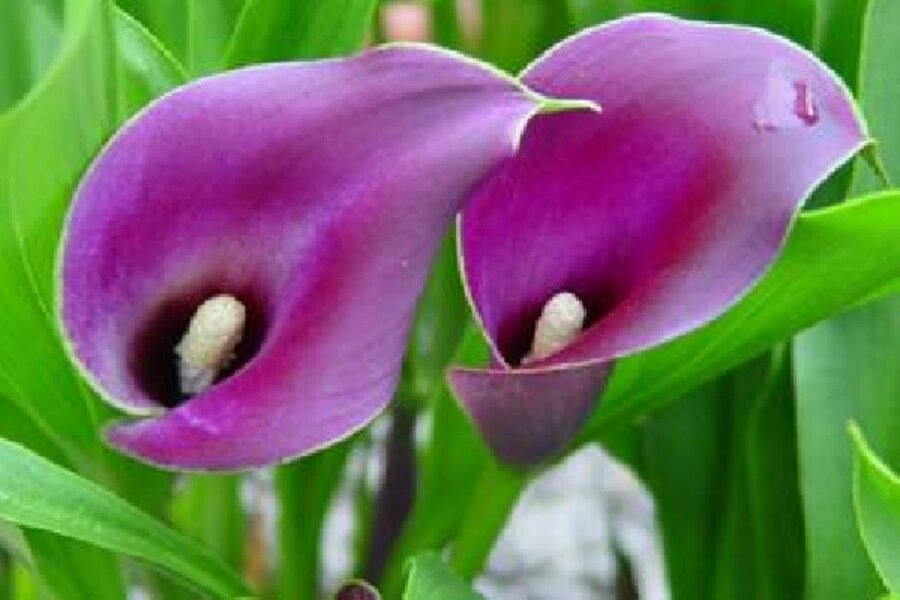That tantalizing tropical touch
Loading...
Despite the long and brutish winters where I live, our shortish summers are mostly sultry and subtropical. I take advantage of this enviable, if occasionally fleeting, condition by growing summer bulbs that will lend the garden a decidedly tropical flair. And you can, too.
This may be the ultimate in gardening’s zonal denial – tropics on the tundra. Call it canna-banana-lantana gardening.
Most gardeners are familiar with spring bulbs, which must be planted in the fall. Tulips, daffodils, crocuses … you dig a hole, drop in a bulb, cover it up, and you are virtually guaranteed flowers a few months hence.
Same deal for summer bulbs. Except you can get really exotic, in both flowers and foliage, and these bulbs mostly perform all growing season long, even during the really torpid weeks when the rest of your plants are frying and dying.
The only proviso on this style of gardening is that most of the bulbs must be lifted (i.e., dug up and stored in the cold nether regions of your basement or garage) for them to overwinter.
I have a small tropical courtyard at my place in rural Iowa where almost everything comes indoors before Thanksgiving. The black elephants’ ears, the bronze-leaved dahlias, the various variegated canna lilies, even the callas – these bulbs all get put in plastic grocery sacks filled with peat moss for the winter.
The entire collection takes up only a small corner of the coal bin where I store firewood.
The only “bulb” that takes up any more room than that is the banana. Yes, bananas are a kind of bulb, too. Corm, actually. And because they have almost no root system at all, they are easily dug up and hauled inside.
You can buy a little tiny banana tree with purple specks on its leaves for about $12 at one of the big box stores in the spring, and by fall it will be shoulder high and sending up new growth (read: new trees).
In my area, you’ll never get any fruit, but after two or three years you can have quite a stand of banana trees, which give quite a tropical feel to your yard.
Most summer bulbs multiply quite rapidly as well, assuredly giving better returns that the stock market of late. It used to be that certain Southern perennials were tagged “pass-along plants” because it was so easy to share them with friends and family. Summer bulbs are the same way.
Those big-leaved green elephants’ ears and most cannas are manic in their intention to reproduce. And you will look quite magnanimous handing tropicals out to your garden buddies hither and thither. (Admit it: You gently refuse their offers of phlox and lilies-of-the-valley.)
And here’s an admission on my part: I don’t always lift all my summer bulbs. If the bulbs are cheap (and many of them are), it’s not worth my time to go after them all.
And if the bulbs are really tiny (caladiums, those purple oxalis, the undeservedly maligned gladiolas), you couldn’t pay me to search for them all.
Brent Heath, the chief honcho at Brent and Becky’s Bulbs, says there is no shame in treating some summer bulbs as annuals, and he now gives you license to do so. (Bless you, Brent.)
This approach is certainly cheaper than planting hybrid tea roses, which have a winter survival rate hereabouts approaching, well, zero.
Here are some other things tropic-tinged summer bulbs do well:
• Many of them have exceedingly attractive leaves as well as flowers, so they give garden oomph all season long.
• Many of them thrive in shade, adding color and texture to what might be problem areas. Ferns look superb with tropicals.
• Got a boggy spot in the yard? Many summer bulbs adore wet conditions. As Microsoft would say: It’s not a bog, it’s a feature.
• Bulbs such as dahlias, cannas, and pineapple lilies are ideal cut flowers. The more you remove flowers, the more they pump them out. “Cut and come again,” they call it.
• Summer bulbs – all of them, without fail – are admirable container plants. This makes lifting a non-event. You can put the whole pot in the basement and forget about it until spring.
But the main reason to grow summer bulbs is … because you can. And then you will be able to say that, yes, it’s true: It’s a jungle out there.
Editor’s note: For more on gardening, see the Monitor’s main gardening page. Our blog archive. Our RSS feed.
You may also want to visit Gardening With the Monitor on Flickr. If you join the group (it’s free), you can upload your garden photos — and possibly win a prize. Deadline is Aug. 11. Join the discussions and get answers to your gardening questions.





